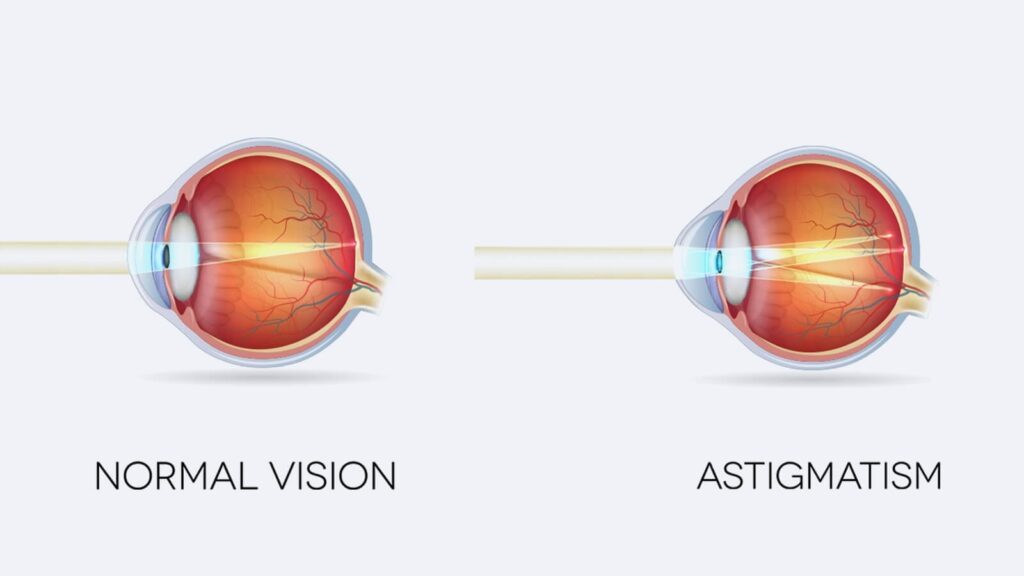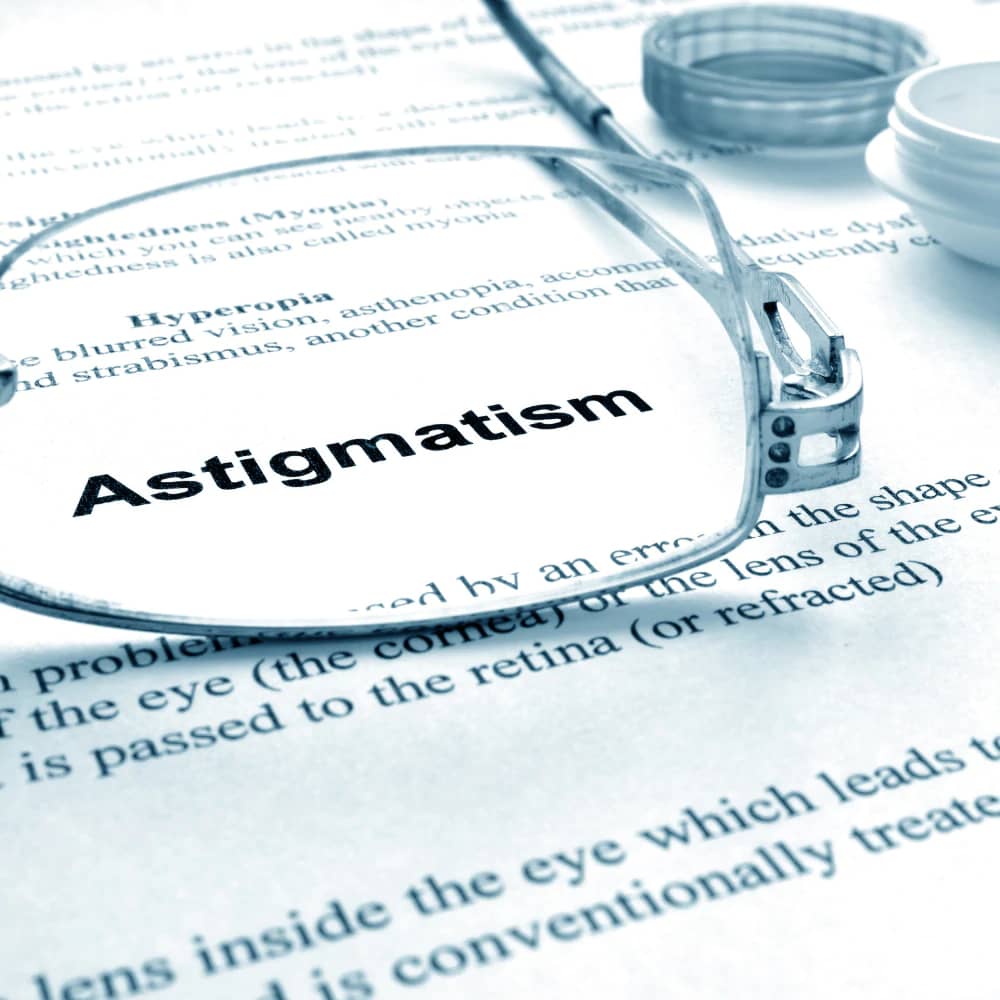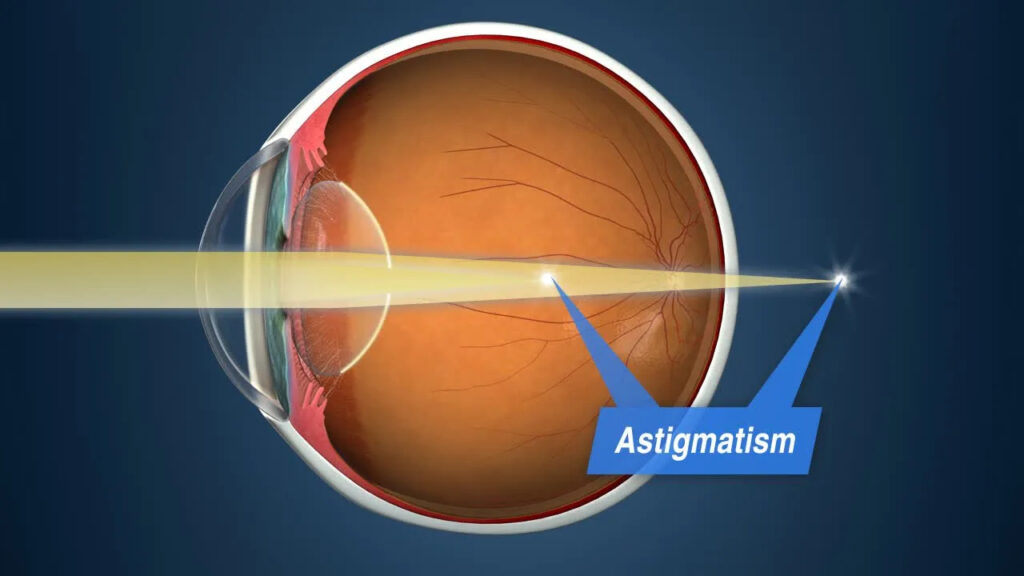WHAT IS ASTIGMATISM?
Astigmatism is a frequent and usually treatable imperfection in the curvature of the eye that causes blurred distance and near vision.
Astigmatism happens when either the front surface of the eye (cornea) or the lens inside the eye has mismatched curves. Rather than having one curve similar to a round ball, the surface is egg-shaped. It results in blurry vision at all distances.
Astigmatism is often present at birth and might occur in combination with nearsightedness or farsightedness. Often, it is not pronounced enough to need corrective action. When it is, treatment options include corrective lenses or surgery.
SYMPTOMS
Signs and symptoms of astigmatism might include:
- Blurred or distorted vision
- Eyestrain or discomfort
- Headaches
- Difficulty with night vision
- Squinting
WHEN SHOULD YOU SEE A DOCTOR?
See an eye doctor if your eye symptoms detract from your enjoyment of activities or interfere with your ability to perform daily tasks. An eye doctor could determine whether you have astigmatism and, if so, to what degree. He or she could then advise you of your options to correct your vision.
Children and adolescents
Children might not realize their vision is blurry, so they need to be screened for eye disease and have their vision tested by a pediatrician, an ophthalmologist, an optometrist, or another trained screener at the following ages and intervals.
- During the newborn period
- At well-child visits till they reach school age
- During school years, every one to two years at well-child visits, at the eye doctor, or by the school or public screenings
CAUSES
The eye has two structures with curved surfaces that bend (refract) light over the retina, which makes the images:
- The cornea, the clear front surface of an eye along with the tear film
- The lens is a clear structure inside the eye that changes shape to help the eye focus on nearby objects
In a perfectly shaped eye, each of these elements has a round curvature, similar to the surface of a smooth ball. A cornea or lens with such a curvature bends (refracts) all incoming light equally to make a sharply focused image directly on the retina at the back of the eye.
A refractive error
If either the cornea or the lens is egg-shaped with two mismatched curves, light rays are not bent the same, which means that two different images form. These two images overlap or combine and lead to blurred vision. An astigmatism is a form of refractive error.
Astigmatism happens when the cornea or lens is curved more steeply in one direction than in another. You have corneal astigmatism in case your cornea has mismatched curves. You have lenticular astigmatism in case your lens has mismatched curves.
Either type of astigmatism could cause blurred vision. Blurred vision might occur more in one direction: horizontally, vertically, or diagonally.
Astigmatism might be present from birth, or it might develop after an eye injury, disease, or surgery. Astigmatism is not caused or made worse by reading in poor light, sitting too near to the television, or squinting.
Other refractive errors
Astigmatism might occur in combination with other refractive errors, which include:
- Nearsightedness (myopia) – This happens when the cornea is curved too much or the eye is longer than usual. Instead of being focused accurately on the retina, light is focused in front of the retina, making distant objects seem blurry.
- Farsightedness (hyperopia) – This happens when the cornea is curved too little or the eye is shorter than usual. This effect is the opposite of nearsightedness. When the eye is in a relaxed condition, light never comes to a focus at the back of the eye, making nearby objects seem blurry.
DIAGNOSIS
Astigmatism is diagnosed with an eye examination. A complete eye examination involves both a series of tests to check eye health and refraction, which determines how the eyes bend light. Your eye doctor might use various instruments, aim bright lights directly at your eyes and ask you to look through several lenses. Your doctor uses these tests to examine different aspects of your eyes and vision and to determine the prescription required to provide clear vision with eyeglasses or contact lenses.
TREATMENT
The aim of treating astigmatism is to improve vision clarity and eye comfort. Treatments consist of corrective lenses and refractive surgery.
Corrective lenses
Wearing corrective lenses treats astigmatism via counteracting uneven curvatures of your cornea or lens.
Types of corrective lenses include:
- Eyeglasses – Eyeglasses are made from lenses that help compensate for the uneven shape of the eye. The lenses make the light bend into the eye correctly. Eyeglasses could also correct for other refractive errors, like nearsightedness or farsightedness.
- Contact lenses – Like eyeglasses, contact lenses could correct most astigmatism. These are available in various types and styles.
Contact lenses are also used in a procedure known as orthokeratology. In orthokeratology, rigid contact lenses are worn at night while sleeping until the curvature of the eye evens out. Afterward, the lenses are worn less frequently to maintain the new shape. If the treatment is discontinued, the eye returns to its former shape and refractive error.
Wearing contact lenses for extended periods of time increases your risk of infection in the eye.
Ask your eye doctor about the pros and cons and risks of contact lenses and what may be best for you.
Refractive surgery
Refractive surgery improves vision and reduces the require for eyeglasses or contact lenses. An eye surgeon uses a laser beam to reshape the curves of the cornea, which rectifies the refractive error. Before surgery, doctors will evaluate you and determine if you are a candidate for refractive surgery.
Types of refractive surgery for astigmatism include:
- Laser-assisted in-situ keratomileusis (LASIK) – With this procedure, an eye surgeon makes a slim, hinged flap in the cornea. He or she uses an excimer laser to create the shape of the cornea and then repositions the flap.
- Laser-assisted subepithelial keratectomy (LASEK) – Instead of creating a flap in the cornea, the surgeon loosens the cornea’s slim protective cover (epithelium) with special alcohol. He or she uses an excimer laser to alter the curvature of the cornea and then repositions the loosened epithelium.
- Photorefractive keratectomy (PRK) – This procedure is just like LASEK, except the surgeon removes the epithelium. This will grow back naturally, conforming to the cornea’s new shape. You might need to wear a bandage contact lens for a few days after surgery.
- Epi-LASIK – It is a variation of LASEK. The surgeon uses a special mechanized blunt blade — rather than the alcohol — to separate a very thin sheet of epithelium. He or she then uses an excimer laser to remake the cornea and repositions the epithelium.
- Small-incision lenticule extraction (SMILE) – This newer type of refractive surgery reshapes the cornea by using a laser to make a lens-shaped bit of tissue (lenticule) beneath the cornea’s surface. The lenticule is then removed through a very tiny incision. At this point, the SMILE procedure is only approved for treating mild nearsightedness.
Other types of refractive surgeries are clear lens extraction and implantable contact lenses. There is no one best method for refractive surgery, and you should make a decision only after a complete evaluation and detailed discussion with your surgeon.
Some of the possible complications that could occur after refractive surgery include:
- Undercorrection or overcorrection of your original problem
- Visual side effects, like a halo or starburst appearing around lights
- Dry eye
- Infection
- Corneal scarring
- Rarely, vision loss
Discuss the possible risks and benefits of these procedures with your eye doctor.
If you or anyone you know is suffering from astigmatism, our expert providers at Specialty Care Clinics will take care of your health and help you recover.
Call us on (469) 545-9983 to book an appointment with our specialists.




